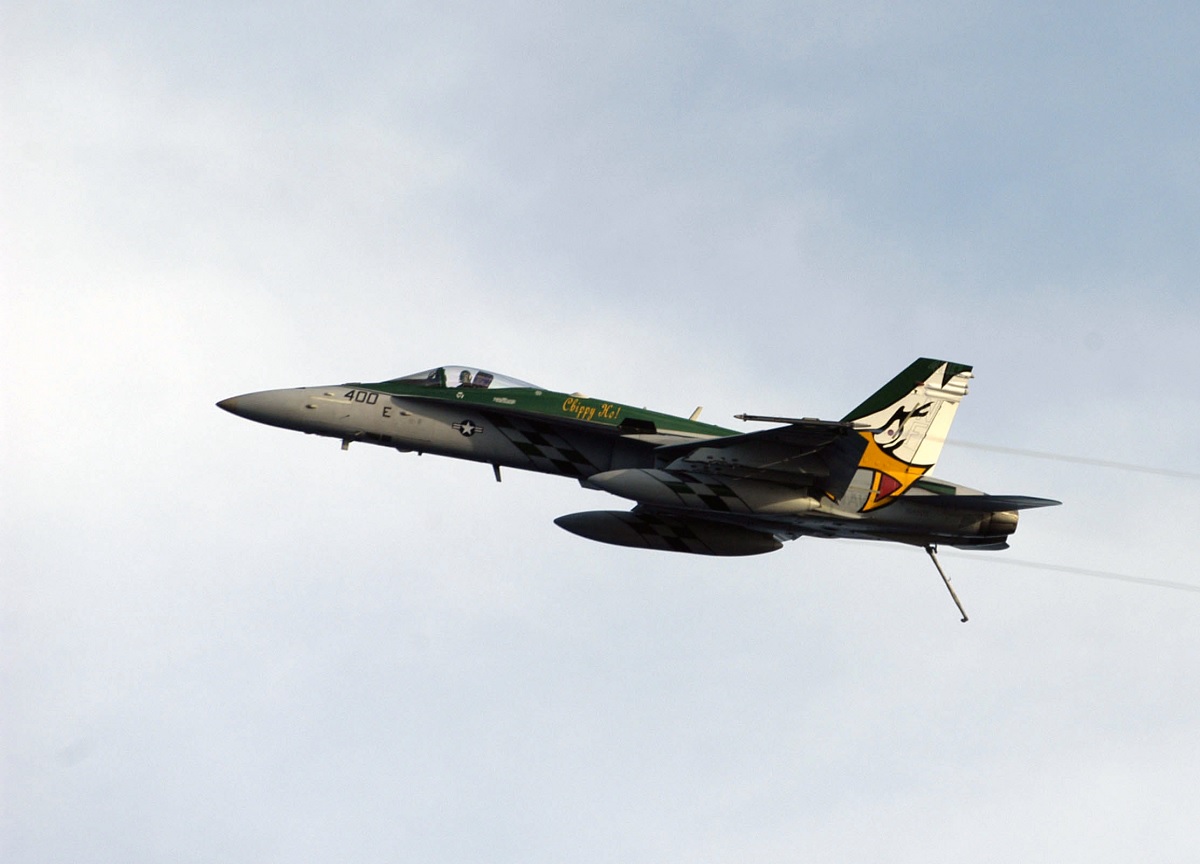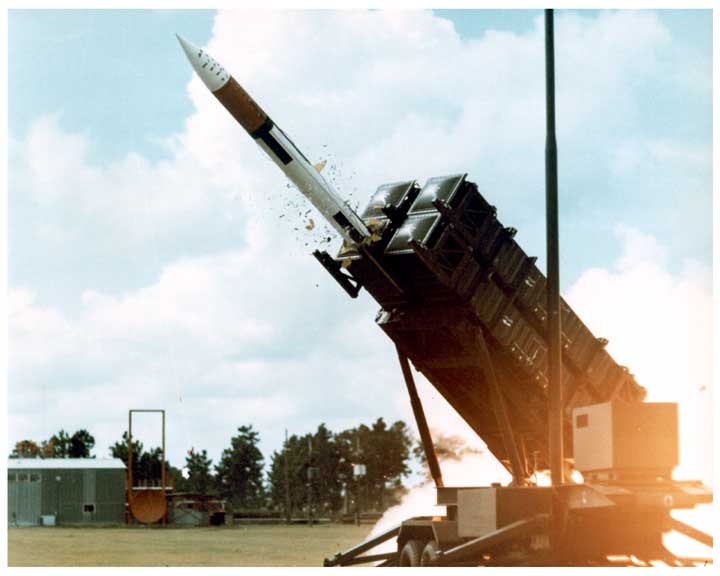“The Patriot is by far the most lethal SAM system in the world, and there is no aeroplane in existence that is going to get away from it. The missile itself is also designed to bias its impact on the nose of the aircraft so as to kill the pilot. If a Patriot is fired at your aircraft, you might as well eject, as there is nothing you can do to get away from it,” Lt. Cdr. Ron Candiloro, VFA-151’s F/A-18 Hornet pilot
Around 250 F/A-18 Hornets participated in combat during Operation Iraqi Freedom (OIF) from land bases and the six U.S. Navy supercarriers stationed in the Northern Arabian Gulf (NAG) and the eastern Mediterranean. The F/A-18 Hornet served as the “universal soldier” of the war effort.
Between March 19 and April 18, 2003, the F/A-18s and other Naval TACAIR types performed an incredible 5568 combat missions, dodging hostile AAA and SAMs, bad weather, and crowded skies to guarantee a Coalition victory in the shortest amount of time. No Navy aircraft was lost as a consequence of enemy action due to the forceful pre-war training, vast air supremacy, and effective tactics. One navy aviator, regrettably on his own side, was killed in action during OIF.
In accordance with Tony Holmes and Chris Davey’s explanation in their book U.S. Navy Hornet Units of Operation Iraqi Freedom (Part One), Lt. Nathan White of CVW-5’s VFA-195 had taken off from USS Kitty Hawk (CV-63) on the night of April 2, 2003, on what was intended to be a routine kill box interdiction/close air support (KI/CAS) mission in support of troops approaching Baghdad.
Since March 19, White and his squadron mates have been actively engaged in the ground campaign, working particularly alongside components of V Corps. When White and his wingman entered Iraq, their E-2 controller gave them directions to Karbala, which is located 50 miles south of Baghdad. In order to clear the way for mechanized units moving north, air support was requested since elements of the 3rd Infantry Division were experiencing fierce resistance in the area.
When Lt. White’s Hornet was assaulted by a U.S. Army-manned mobile PAC-3 Patriot missile battery in south-central Iraq, it is unknown if he had already bombed his targets and was returning home or was still on route there. The shattered F/A-18C crashed into a lake in an Iraqi Air Force bombing range near Karbala, and its location subsequently hampered efforts made by the U.S. Army’s Tactical Recovery of Aircraft and Personnel or TRAP team to recover Lt. White’s body. His jet was destroyed by the weapon, and neither the aircraft nor the pilot’s remains were discovered for another ten days. The pilot’s remains were eventually found in the lake on April 12; 12 days later, he was laid to rest in Arlington National Cemetery with full military honors.
Ironically, in the final email he sent to his family before his unfortunate death, Nathan White made a passing reference to the threat posed by the Patriot batteries. “When going in on a strike, there is always a lot going on. Here is a brief snapshot – brief for an hour or more to map out the flight, get catapulted from standstill to 140 miles an hour in less than two seconds, navigate through a maze of airborne highways that try to deconflict aircraft, and of course, steer you clear of the Army’s Patriot batteries, jump from radio frequency to radio frequency at least 12 different times, shifting from controller to controller, avoid a sky full of AAA, surface-to-air missiles and ballistic rockets, set up your weapons system, acquire your target, drop on target, fly to an airborne tanker, join up, get gas and then fly back and land on a boat bobbing around in the middle of a sandstorm. Make it nighttime and throw in thunderstorms, and then it really gets exciting.”
Prior to the start of OIF, Navy pilots had expressed concerns about the deadly Patriot missile, but their worries increased after No. 9 Sqn RAF lost a Tornado GR 4 on the morning of March 23 while it was returning to Ali Al-Salem airport in Kuwait following a strike operation.
VFA-151’s Lt. Cdr. Ron Candiloro explained: “Although I remained wary of the Iraqi SAM threat, I was actually more afraid of our own Patriot batteries. We would commonly get lit up by the missile’s fire control radar, and that was really scary. These lock-ups increased in frequency as our forces moved further north into Iraq, and this prompted my CO. Cdr Hubbard, to investigate a daily briefing that told us all where the Patriot batteries were all over the country. A copy of this information was also painted onto a card that we carried with us in the cockpit. I felt that this was the most important briefing card issued to me before every mission, and it was always at the top of my knee war pack – I was terrified by the Patriot.
“It is by far the most lethal SAM system in the world, and there is no aeroplane in existence that is going to get away from it. The missile itself is also designed to bias its impact on the nose of the aircraft so as to kill the pilot. If a Patriot is fired at your aircraft, you might as well eject, as there is nothing you can do to get away from it.
“We could clearly tell if a Patriot battery was looking at us, as our ALR-67 radar homing and warning system would clearly indicate that we had been locked up by the missile’s search radar. When this happened, the jet’s Mode 4 IFF (Identification Friend or Foe) was supposed to ‘squawk’ (reply) to the Patriot’s radar with an encrypted signal which indicated to the missile that its ‘target’ was in fact friendly. […] The Patriot batteries were initially operated in automated mode, which meant there was no human interaction in the way it interrogated targets. For 99.9 percent of the time, the system worked fine, but twice it did not, although there is some question as to whether the Tornado GR 4’s IFF functioning correctly when it was shot down.”
Candiloro explains: “We had started to get concerned about the Patriot in automated mode after the Tornado was lost, and when the Hornet was downed we really started to question what exactly the Army was doing with the weapon. Our concerns traveled ‘up the chain’, and that was when the Army changed the Patriot’s engagement parameters from auto to manual, which meant that a human operator had to input the direction to fire. That gave us more peace of mind, but unfortunately, it had cost three lives to get this change made.”

“Psychologically, the loss of tow jets to Patriot missiles had a big impact on the air wing,” concludes Candiloro. “Heading into Iraq, I was confident that I could handle literally anything that the enemy threw at me. Indeed, I was more scared of what our guys were going to do to me, and in particular the Patriot batteries. It was a big relief when you finally got out of Iraq and left the last of the Army’s missile batteries behind you near the end of every sortie.”
Photo by Photographers Mate 3rd Class Jonathan Chandler / U.S. Navy


